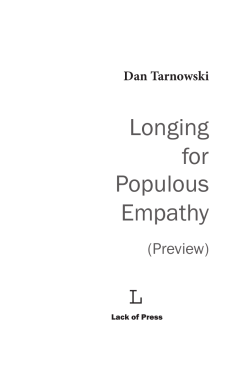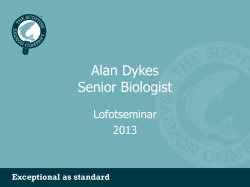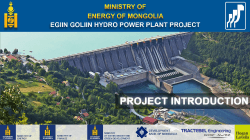
Assessment of Heavy Metals in Sediment and Tissues of
Journal of Novel Applied Sciences Available online at www.jnasci.org ©2015 JNAS Journal-2014-4-3/385-389 ISSN 2322-5149 ©2015 JNAS Assessment of Heavy Metals in Sediment and Tissues of Gara Fish from the City of Khash, South East of Iran Sanaz Khammar1* and Esmaeil Karamzahi2 1- Department of Environmental Sciences, Faculty of Natural Resources and Environmental, University of Birjand, South Khorasan, Iran 2- As graduated of Environmental engineering, University of Zabol Corresponding author: Sanaz Khammar ABSTRACT: In the present study, some heavy metals (Zn, Cu, Ni and Pb) in sediment and their accumulation in Gara organs (gill, muscle, fin and gonads) were investigated. For this purpose, samples were collected from three rivers Eskel Abad, Dehpabid and Bidaster in the city of Khash,(South East of Iran) in spring 2013. Heavy metal levels in sediment and fish samples were analyzed by atomic absorption device Konic NOVAA300 according to the proportion of μg/g in dry weight.The analysis of heavy metals in sediments indicated that among the four heavy metals tested, Zn had the highest concentration, followed by Cu, Ni and Pb. Studies on all the different parts of the fish revealed Zn had the highest accumulating level in fish and Pb and Ni had the lowest. According to the results, heavy metal concentrations in the edible parts of Gara were well within the limits set by the FDA,WHO, NHMRC and UK MAFF recommendations and showed that the fish from investigated region are safety permissible level for human consumption. Keywords: Heavy Metals, Gara, Accumulation, Sediment. INTRODUCTION The aquatic environment with its water quality is considered the main factor controlling the state of health and disease fishes. But, the aquatic ecosystems pollution with contaminants has become a matter of great concern over the last decades. Three rivers Eskel Abad, Dehpabid and Bidaster are the major rivers in the city of Khash in the South East of Iran. These three sampling sites, have always played a key role in the water management of the city of Khash in the past, and were used as sources of water. But in recent years, the substantial development of urban and industrial activities result in increasing inputs of chemical contaminants which lead to the loss or alteration of Gara habitat. Among environmental pollutants, metals are of particular concern, due to their potential toxic effect and ability to bioaccumulate in aquatic ecosystems (Censi et al., 2006). Heavy metal concentrations in aquatic ecosystems are usually monitored by measuring their concentrations in water, sediments and biota (Camusso et al., 1995). Sediment quality is a good indicator of pollution in water column, where it tends to concentrate the heavy metals and other organic pollutants. Some kinds of toxic sediments kill benthic organisms and decrease the food availability for larger animals such as fish. Bioaccumulation and magnification is capable of leading to toxic level of these metals in fish, even when the exposure is low. Many aquatic organisms have been used as bioindicators, including aquatic insects (Rayms-Keller et al., 1998), plants (Mohan and Hosetti., 1999), protozoans (FernandezLeborans and Olalla-Herrero, 2000), crustaceans (Allinson et al., 2000) and fish (Burger et al., 2002). Fish samples are often the top consumers in aquatic ecosystems (Dallinger et al., 1987), thus fish samples are considered to be one of the most indicative factors in freshwater systems, for the estimation of trace metals pollution potential (Papagiannis et al., 2004). The aim of the present study was to determine the metals concentrations (Pb, Zn, Ni, and Cu) in sediments and in muscle, fin, gonads and gill tissues of Gara . J Nov. Appl Sci., 4 (3): 385-389, 2015 MATERIALS AND METHODS Description of the study area Three freshwater ecosystems Eskel Abad, Dehpabid and Bidaster are located in the city of Khash, Sistan and Baloochestan Province, South East of Iran ( figure 1) and have a Mediterranean climate. Geographical location of the study areas are shown in Table 1. The selected species (Gara) are popular fishermen. This fish is an important component of the human diet in this zone. It is silvery grey above and fins , white beneath. But, the quality of this ecosystem has been degrading due to disturbance from human activity (agricultural, industrial, domestic or fishing). Since then, from literature review, no work has been carried out on the environmental quality of sediments and biota of three aquatic ecosystems, this is why the results obtained from this study would provide information for background levels of metals in the sediment and fish samples, contributing to the effective monitoring of both environmental quality and the health of the organisms inhabiting the freshwater ecosystems. Figure1. Map showing study areas Table 1. The position of sampling areas Samples stations Station 1: Dehpabid River Station 2: Bidaster River Station 3: Eskel Abad River Geographical Position 28°36'29.974"N 28°34'30.678"N 28°34'26.417"N 60°46'32.297"E 60°48'15.228"E 60°48'18.903"E Sampling and sample preparation Sediment and fish samples were collected from three stations Eskel Abad, Dehpabid and Bidaster in the city of Khash(South East of Iran) in spring 2013. A total of 45 fish samples from three sampling sites were analyzed with a mean weight. Fish samples were transported to the laboratory in box with ice. All fish samples were kept at -30°C until analysis. Each fish was properly cleaned by rinsing with distilled water to remove debris planktons and other external adherent. The fishes dissected to separate organs (gill, muscle, gonads and fin) to investigate heavy metals. Next, the extracted parts were put in the oven for 48 hours in 80˚c to be dried and Powdered completely . To digest the fish samples, 1gr of each powdered fish sample was mixed in 10 ml pure concentrated nitric acid (65%) and hydrochloric acid by the proportion 4:1 to digest. Then they were put in the water bath for the next 2 hours in 140˚c to be digested. After this, the samples were diluted using double distilled water to the volume of 50 ml and then they were filtered using Whatman 42 micron filter paper (Abdul-Wahab and Jupp., 2009). To determine the amount of heavy metals in fish samples (gill, muscle, gonads and fin) 3 repetitions were picked. Sediment samples from a depth of 15 cm were collected using steel shovel at every station (3 repetitions) and returned to the laboratory in polyethylene bags. The sediments were kept in oven for 3 days at 80˚c to dry off. Once sediment samples dried they were powdered and passed through 63 μm sieve. The samples packed in polyethylene bags and stored to analysis. The sediment samples were weighed 1g and the same procedure, digested fish samples, was carried out for dried sediment samples. Heavy metal concentrations were measured using atomic absorption spectrometry Konic (FAAS) model Novaa 300 in gram in dry weight gram. 386 J Nov. Appl Sci., 4 (3): 385-389, 2015 Statistical analysis The statistical analysis was performed by SPSS software (version 14). Data were tested for normality using Kolmogorov–Smirnov test. After making sure of data normality, the concentration differences of each metal for every tissue (gill, gonads, fin and muscle) and the sediments was measured using the One Way ANOVA and to separate the groups, the Tukey-test was used. And, Microsoft Excel was used to draw the charts. P < 0.05 was counted as being significant. RESULTS AND DISCUSSION Heavy metals in sediment: Table 2 shows the sediment quality constituents of study areas, and other global published values in different sites. The results showed the metals concentrations in bottom sediment varied widely and decreased in the sequence of Zn > Cu >Ni > Pb. The data indicated that Zn was maximally accumulated in the sediment whereas Pb got the least concentration. Metals exhibited a similar pattern of concentration as its abundance in water. The presence of Cu, Ni, Pb and Zn in sediments of sampling sites is mostly due to anthropogenic sources as there are no sources of natural inputs in the region. Urban and industrial developments are among the contamination sources that directly impact sediments in these regions. Sediments act as the most important reservoir or sink of metals and other pollutants in the aquatic environment (Gupta et al., 2009). Heavy metal contamination in sediment can affect the water quality and bioaccumulation of metals in aquatic organisms, resulting in potential long-term implication on human health and ecosystem (Fernandes et al., 2007). Table 2.Comparison of metal concentrations in sediment samples from this study and other study areas (concentration unit is in μg g-1 dry weight) Locality Dehpabid River Bidaster River Eskel Abad River Gediz River, Turkey Lake Tanganyika PECf Avsar Dam Lake St Lake Geneva Lake Texoma Zn 223.5 215.4 210.5 160 28.36 459 - Cu 167.5 158.2 160.9 140 20.81 111 29.98 727 38 Ni 23.8 30.1 15.2 135 29.99 87 17 Pb 9.00 4.03 4.03 128 14.0 158 2.44 620 10 Refereces Present study Uzunoğlu, (1999) Chale, (2002) NOAA , 2009 Öztürk et al, 2009 Pote et al, 2008 An and Kampbell, 2003 Heavy metals in fish tissues: The mean concentrations of heavy metals in different Gara fish tissues and research conducted are presented in Table 3. samples decreased in the sequence for the gill as Zn > Cu > Ni > Pb; muscle as Zn > Cu > Pb >Ni ; gonad as Zn > Cu > Ni> Pb and fin as Zn >Cu > Ni > Pb. In this study, it is obvious that Zn has the highest concentration, while Ni and Pb have the lowest concentration of all measured metals in fish organs. The results showed the concentrations of metals in muscle tissue of all stations, there were significant differences, so that the Zn had the highest concentration and Ni the lowest concentration. The highest concentrations Zn in fish muscle was observed at station Bidaster, but the concentration Zn was not significantly different stations Eskel Abad and Dehpabid. There was the lowest concentrations Cu and Pb in muscle tissue at the station Dehpabid. Although the highest concentrations Cu and Pb achieved in stations Eskel Abad and Bidaster but there was no significant difference. Ni concentration in muscle tissue showed no significant differences between the 3 stations surveyed. In the present Research, the order of metals corresponded with the results Khosravi et al (2011) found in muscle tissue of Esox luciusn. According to the study, the concentrations Zn in gonad tissue was significantly different at the stations Bidaster and Dehpabid and a trend of increasing concentrations was from Ni and Pb to the Cu and Zn.The study of heavy metals in the Trachurus mediterraneus species concluded by Yilmaz (2003), the amount Zn was obtained in muscle 38.23 mg/kg and gonad 56 mg/kg , the data obtained in our study was far less than that of Yilmaz′s study. By evaluating the results, we found that concentrations Zn in gill tissue had significant differences at the stations Dehpabid and Bidaster and we have seen increasing trend metal concentrations from Pb and Ni to the Cu and Zn. In gill Zn followed by Cu showed higher concentrations and Pb and Ni the lowest. This could be explained by the fact that Zn and Cu are essential elements in the bodies of living organisms and have an important role in different physiological processes. The concentration level in the gills could also be attributed to the fact that water always passes through mouth and gill when the water is filtered, this is correlated with the findings of food and agricultural 387 J Nov. Appl Sci., 4 (3): 385-389, 2015 organization (Adeniyi and Yusuf., 2007; (Bryan.,1971 ; Sreenivasa et al., 2003). Ray et al (1990) with the evaluation of concentrations Ni, Cu, Pb in the gills and muscle tissue of Clarris batrachus found some similar results. The major total body part of loads accumulated at various metals concentrations in the water and at different exposure times are found in kidney, liver and gills (Al-Mohanna, 1994; Kock et al., 1998; Giguere et al., 2004). Metal concentration in the gills could be due to complexing of the elements with mucus, which is impossible to remove completely from between the lamellae, before tissue analysis preparation. Thus, high concentrations of various metals can be observed (Heath, 1987). Results showed significant differences in Zn in fin tissue at the stations Bidaster and Dehpabid and there was a sequence of increasing metal concentrations from Pb and Ni to the , Cu and Zn. Results of many research indicated that metals exhibit various affinity to fin organ (Marzouk, 1994). Alam et al. (2002) have reported the concentrations of elements in the muscle, gill, and gonads of cultured and wild carps caught in Lake Kasumigaura, Japan. The heavy metal levels in Gara fish were lower than what Alam et al. have reported. This may be due to the difference of feeding habits of the where the carps caught fish is mainly omnivorous feeding on fish, insect larvae, mollusks, planktonic organisms and water weeds which accumulate large amounts of heavy metals. Results of many research indicated that metals exhibit various affinity to fin organ (Marzouk, 1994). Table 3. Comparison of metal concentrations in the tissues of Gara fish and other studies (concentration unit is in μg g-1 dry weight) Element Zn Cu Ni Pb Zn Cu Ni Muscle 4.1 3.7 0.1 0.2 4.4 4.3 0.3 Fin 3.9 1.2 0.2 0.1 3.7 1.2 0.2 Gill 4.3 1.2 0.2 0.1 3.7 1.2 0.2 gonad 4.4 1.2 0.2 0.1 3.8 1.6 0.2 Pb Zn 0.9 4.3 0.1 - 0.1 - 0.1 - Cu Ni Pb Ni 4.2 0.4 0.9 0.63 0.24 0.039 0.15 0.09 - 1.04 0.26 0.14 0.36 0.07 - Cyprinus carpio Hipophthalmichthys molitrix Tilapia Silver bream Hipophthalmichthys molitrix Vindohini and Narayanan, 2008 Pakzad, 2013 Abdel-Baki et al, 2011 Staniskiene et al, 2006 Pakzad, 2013 Cu 1.08 - 2.06 - Tilapia Abdel-Baki et al, 2011 Zn 41.01 14.82 38.23 - 53.80 47.39 - 56 Hipophthalmichthys molitrix Silver bream Trachurus mediterraneus Pakzad, 2013 Staniskiene et al, 2006 Yilmaz, 2003 Pb Species References Dehpabid River Gara Bidaster River Eskel abad River Table 4. Comparison of metal concentrations in muscle tissue with existing standards (concentration unit is in μg g-1 dry weight) Standards WHO Zn 30 Pb 0.4 Ni 0.38 Cu 10 FDA NHMRC UK MAFF Dehpabid River 35 150 50 4.1 5 1.5 2 0.2 1 0.1 10 20 3.7 Eskel abad River 4.3 0.9 0.4 4.2 Bidaster River 4.4 0.9 0.3 4.3 References European Commission, 2000 Pourang et al, 2004 Pourang et al, 2004 Pourang et al, 2004 Pourang et al, 2004 Present study 388 J Nov. Appl Sci., 4 (3): 385-389, 2015 CONCLUSION In this study the effect of stress ratio (K0) on the boundary conditions is investigated and could be used as initial parameter for modeling of tunnels. Overall, the rocks with strain-softening behaviour have the effect of localization of deformation and causes instability problems for underground openings. The following conclusions could be noted: - Numerical analysis of K0 in the tunnels shows that for all boundary conditions, with decreasing the values of K 0, the displacement around tunnels has increased. - In modeling of tunnels, the shape of the external boundary is important and the external boundaries circle, hull and box to cause maximum displacement around tunnels, respectively. - In the rocks with strain-softening behaviour, by increasing the values of GSI, the displacement around tunnels has strongly decreased for all boundary conditions. REFERENCES Alejano LR, Rodr´ıguez-Dono A, Alonso E and Fern andez Manin G. 2009. Ground reaction curves for tunnels excavated in different quality rock masses showing several types of post-failure behaviour. Tunnelling and Underground Space Technology 24 689–705. Goodman RE. 1989. Introduction to Rock Mechanics, 2nd. Wiley. Hill R. 1950. In: The mathematical theory of plasticity. New York: Oxford University Press. Hoek E, Carranza-Torres C and Corkum B. 2002. Hoek–Brown Failure Criterion—2002 Edition. Rocscience. Hudson JA. 1991. Atlas of rock engineering mechanisms: underground excavations. Int J Roc Mech Min Sci Geomech, 523–6. Kaliszky S. 1989. Plasticity: Theory and Engineering Applications. Amsterdam, Elsevier. Rocscience. 1999. A 2D finite element program for calculating stresses and estimating support around the underground excavations. Geomechanics Software and Research. Rocscience Inc., Toronto, Ontario, Canada. Singh B and Goel RK. 1999. Rock Mass Classification, A Practical Approach in Civil Engineering. Elsevier, Amsterdam. 265 pp. 389
© Copyright 2025









